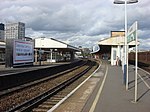Royal Vauxhall Tavern
1863 establishments in EnglandBuildings and structures in the London Borough of LambethEvent venues established in 1863Grade II listed pubs in LondonHistory of the London Borough of Lambeth ... and 4 more
LGBT history in EnglandLGBT nightclubs in LondonLGBT pubs in LondonMusic venues in London

The Royal Vauxhall Tavern is a Grade II listed gay entertainment venue in Vauxhall, London. It is also known as the RVT. It is South London's oldest surviving gay venue.
Excerpt from the Wikipedia article Royal Vauxhall Tavern (License: CC BY-SA 3.0, Authors, Images).Royal Vauxhall Tavern
Kennington Lane, London Vauxhall (London Borough of Lambeth)
Geographical coordinates (GPS) Address Website External links Nearby Places Show on map
Geographical coordinates (GPS)
| Latitude | Longitude |
|---|---|
| N 51.4864 ° | E -0.1219 ° |
Address
The Royal Vauxhall Tavern
Kennington Lane 372
SE11 5HY London, Vauxhall (London Borough of Lambeth)
England, United Kingdom
Open on Google Maps






